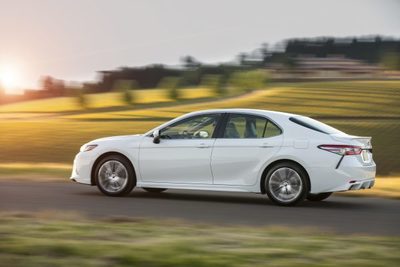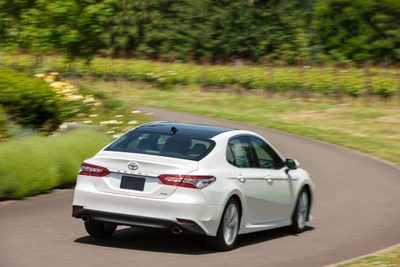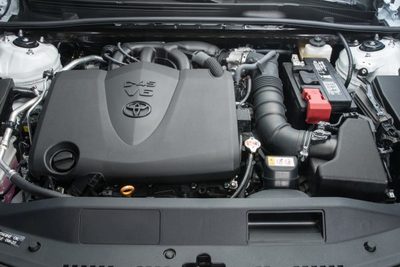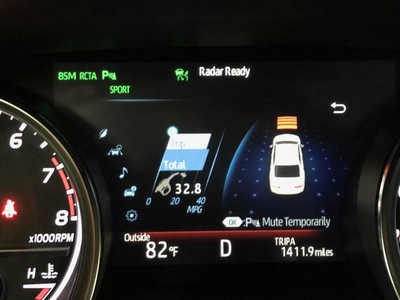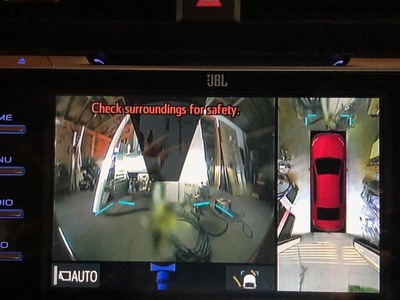2019 Camry XLE Review By Thom Cannell
2019 Camry XLE Review
By Thom Cannell
Senior Editor and Technology GURU
Michigan Bureau
The Auto Channel
Bullet Points—Brief observations based on decade’s of experience.
It had been years since I drove a Toyota Camry the best-selling family sedan in the USA. Camry has never inspired journalists, who typically love diesel engines and station wagons, thus showing how disconnected we are. We all appreciated Camry’s reliability and longevity, not its ride and handling or rather stodgy styling. In 2017, thanks to a new global platform, everything changed.
My first note said, “I don't remember a Toyota, other than their sports cars, offering this much road feel, this level of ride and handling, this kind of responsiveness.” I’d stepped into the 2019 Camry XLE, figured out what was necessary to safely operate a vehicle I'd never driven: hands-free iPhone connection, mirrors set correctly and road trip music selected. Right away, the ergonomics were correct; things needed were at hand, which is surprisingly not always the case. Without a user manual in hand I could understand what I wanted and how to get it when I wanted it. For instance, setting the cabin temperature. Push the button and set to 73°F or push the phone button (on the infotainment system) to link my phone.
Backing out of airport parking, I’d discovered the multi-view camera with a birds-eye view that’s so valuable (to women in particular), and used the blind spot detection (with rear cross traffic alert, maybe the best safety feature this decade). Then I drove out of the parking lot discovering that surprisingly firm platform beneath me on the cobblestone-like pavement near Detroit’s airport.
After a week, I found myself liking this car more and more, that's despite Camry remaining a family-oriented car and regardless the Sport Touring-themed commercials which make you think it may be a car you'd take to the track on weekends. Ah, marketing sizzle!
Three powertrains are available for the 2019 Camry including a 2.5-liter inline-four-cylinder and the naturally aspirated 3.5-liter V6 making 301 horsepower and 267 pound-feet of torque on my XLE. It’s more than enough power and surely a long lasting and fuel-efficient engine as we’ve come to expect from Toyota. Either is paired to an eight-speed Direct-Shift automatic transmission (8AT). The third powertrain variant is a Hybrid.
That 8-speed transmission provides drivers three mode choices including Sport, which is dandy for the enthusiastic driver. It did enhance driving pleasure for me—most of the time. In Sport mode I though the steering become a bit heavier and resistive than I’d prefer, particularly on-center and just off center. Also, in Normal mode I'd like to have improved powertrain aggressiveness. That might be my fault for not teaching the powertrain by enthusiastically pressing the accelerator more of the time.
Unfortunately for the enthusiast the powertrain default when the car starts is ECO, and ECO is the new black for every manufacturer as it focuses on fuel economy regardless your desire for a spirited driving style. So, develop a habit of switching to Normal or Sport or you're quickly into a very high gear, with its lack of throttle response (without a major throttle depression). In Normal mode on the highway at Joneses speed (you know, keeping up with them...) the Camry XLE delivered over 30 MPG without fail. Our final tally showed an overall, 32.4 MPG, which is terrific for a full-sized family sedan.
Today, cars are mobile Internet cafes and home theaters. A prime objective of any car manufacturer is to employ not only great technology, but to make it easy to use. I think the 2019 Camry XLE succeeded. One example is Radar Cruise, which is not perfectly intuitive until you've used it repeatedly. Toyota’s control setup is easy to use with controls for Lane Keep Assist and Distance for the radar-enabled cruise control system under your right thumb. Both systems are easy to use. Radar-based cruise control strives to keep both a set speed and a selectable distance to the vehicle ahead. Such systems will, if you’re inattentive, brake the car for you. There's an important learning process involved, compared to decades-old manual cruise.
In heavy traffic I set my desired speed, and the distance-to-automatic-braking to its greatest interval ahead. As I came up on slowing traffic, the Camry braked hard (great, wonderful), but it braked harder than I'd have, given that my speed was under 30 MPH and the car ahead was 5-7 car lengths away. The concern is, automatic braking can deliver near-maximum braking and if the car behind you is even a bit distracted, or tailgating.... You get the picture, and the insurance premium increase after the plastic is swept up.
I have long been a late-at-night night rally car chaser, thus an advocate for superior lighting systems. On this Camry XLE the headlights were aimed a touch high, but Oh My Goodness, they were ultra-bright LEDs, and equipped with automatic high beams.
On a two-lane I got flashed for not turning off my high beams, so turned on the automatic system. Thereafter, I could see like daylight: Top-Bottom-Left-Right, and my headlights automatically dimmed for a vehicle a full Spartan Stadium ahead of me whether the system saw headlights or tail lights.
Between the speedometer and odometer is a 7-inch color Driver Information display with customizable settings for cruise control and Lane Keeping plus odometer, outside temperature, fuel economy and trip information. You can view current/average fuel economy, distance to empty, average speed, trip distance with timer, tire pressures, even scheduled maintenance and any necessary warning messages.
Because this was an XLE, it was equipped with a premium JBL audio system and optional navigation. Beyond the optional navigation system and JBL audio system displays were pages of information for deep system controls. For instance my Head Up Display (HUD) settings for brightness and elevation were buried in sub-menus. There are pros and cons to that... Overall, the technology won't confound you.
Here’s the Bullet Points…
The Good:
As expected, the Camry XLE delivered comfort in every dimension, from standard LED headlights to 8-way seats for the driver and passenger, and a host of cool technology.
Camry now has crisp, sculpted lines more reflective of an international-inspired modernity replacing the frumpy styling—without cutting off future desirability. Your Camry will look good for years to come.
Technology that’s generally helpful, like the 10-inch HUD displaying basic and advance information “ahead on the road”, so less distraction.
JBL premium audio system with Clari-Fi to make Internet radio sound better includes nine speakers and an amplified subwoofer.
When backing up, the 8-inch infotainment screen displays what's behind almost as quickly as you could turn your head.
Needs Improvement:
Infotainment system preferences. I hope there are ways to show what I prefer, not what the system wants. For instance, awoke showing my Bluetooth connection and fuel economy. I wanted to show my phone. If available, such changes are deep inside.
Oh, and the system assumed I wanted to play audio from my iPhone, once it was paired. Cool, but I got used to pressing a button to switch to SiriusXM.
Cool Hacks:
HUD, Heads Up Display was a useful feature, once I got the height and brightness set correctly. You can display Toyota’s pre-collision indicators, digital speedometer, shift position, a compass, outside temperature and more (V6 models only).



